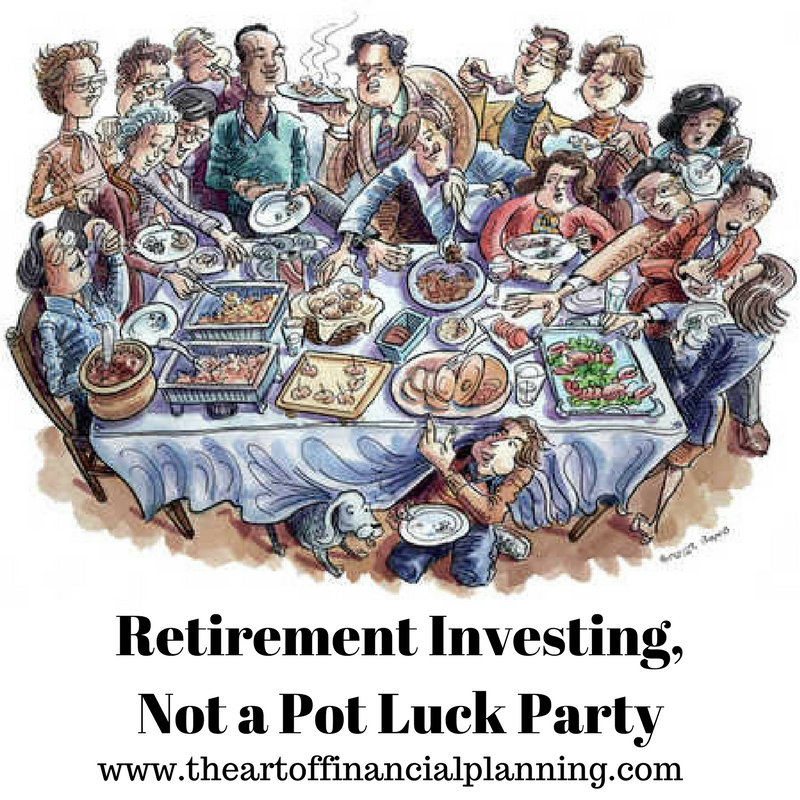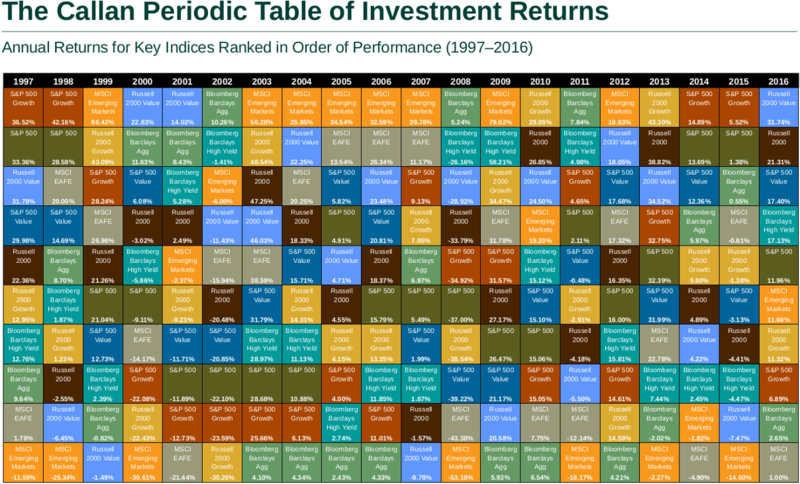Your Retirement Portfolio is Very Important.
I am reviewing a new client’s retirement portfolio from one of the big wire houses’ and I swear there is steam coming out of my ears.
Why you ask? Let me tell you:
These are the contents:
$800,000 invested in a mix of 31 holdings:
10 Individual Stocks 20 Mutual Funds 1 Closed End Fund
There is no perfect amount of holdings for a portfolio, so I have no problem with the number 31.
So what can be so bad?
Well it turns out in this case, it’s very bad.
Because this portfolio is more like a Pot Luck Party, rather than a coordinated investment strategy designed to meet their goals and objectives.
What’s a Pot Luck Party?
Pot Luck Parties are events where the attendees bring a dish to a meal. The only traditional rule is that each dish be large enough to be shared. https://en.wikipedia.org/wiki/Potluck (not endorsed by IFS)
The issue with a Pot Luck is OVERLAP. How many of the same dishes will arrive? -the answer is MANY. While that can be great if it’s an appetizer or dessert everyone loves, but what if it’s a side dish that sits on the table and doesn’t even get a second glance by the guests…
If the host of the party doesn’t coordinate the event properly everyone goes home hungry!
This strategy doesn’t work for your parties or your investment strategy.
It actually can be the most dangerous form of investing.

click here to sign up for all great stuff The Art of Financial Planning has to offer!
Overlap
In the world of investing, overlap can be the killer of your financial success.
Overlap is defined as a
“A situation resulting from owning several mutual funds or exchange-traded funds (ETFs) that hold positions in some of the same securities. Fund overlap reduces the benefits of diversification for the investor.” http://www.investopedia.com/terms/f/fund_overlap.asp#ixzz4c4vE3QQv (not endorsed by IFS)
While small amounts of overlap are to be expected, extreme cases of overlap can expose an investor to high levels of risk.
High levels of risk = high levels of volatility = unexpected movement in a portfolio – which can lead to bad emotional investment decisions!
For this client 12 of the 20 funds have about 70% of the SAME underlying investments!!! Also, those random stocks can be found in 16 of the mutual funds!
With all of this overlap, in reality this client barely has any diversification! And they had no clue!
You see, an investment portfolio that is concentrated in a few positions is considered the most risky, even if it’s holding “Safe” investments.
Those few positions will all move UP AND DOWN together. With nothing to help them balance out any major swings… because that’s where the benefits of diversification comes in.
Diversification
Virtually every investment has some type of risk associated with it. The stock market rises and falls. An increase in interest rates can cause a decline in the bond market. No matter what you decide to invest in, risk is something you must consider.
One key to successful investing is managing risk while maintaining the potential for adequate returns on your investments. One of the most effective ways to help manage your investment risk is to diversify.
Diversification is an investment strategy aimed at managing risk by spreading your money across a variety of investments such as stocks, bonds, real estate, and cash alternatives; but diversification does not guarantee a profit or protect against loss.
The main philosophy behind diversification is really quite simple:
“Don’t put all your eggs in one basket.” Spreading the risk among a number of different investment categories, as well as over several different industries, can help offset a loss in any one investment.
https://www.bogleheads.org/wiki/File:Callan_Periodic_Table_of_Investment_Returns.png (not endorsed by IFS)

Need proof—look at the chart above and you will see the random returns of each asset class.
Being overly invested in 1 asset class could mean the difference of 30 to 50%!
2008 bottom -53% vs top +5.24%
2016 bottom +1% vs top +31%
2012 bottom +4.21% vs top +18%
..and many more
For this client:
This is a classic case of having blind trust in an advisor, who is believed to be an “expert” and “taking care of them.”
Since 2010 the U.S. Stock Market has been mostly positive, so yes this account has made money.
And that is part of the problem.
The client received their statement, saw positive returns and thought all is right in the world.
Never demanded a review meeting and never actually sat down to discuss the investment strategy for this account.
Well, now they are 8 years away from retirement and finally called their Broker, who told them “everything is fine, your account is making money, nothing has to change.”
Something didn’t sit right and they decided to call me, a CERTIFIED FINANCIAL PLANNER®.
Solution
There a series of steps that have to be taken to “Right the Ship” for this client. And it begins with going back to the drawing board.
- Review the client’s financial goals and objectives again to make sure we are on the same page.
- Have a discussion about risk toleration and diversification
- Write up an investment policy statement that covers the asset allocation and rules for buying and selling all positions.
- Select the appropriate investments to cover all asset classes.
- Apply buying/selling rules to the account and monitor it appropriately.
End Result
For the first time, this client feels that their investments are coordinated with their goals. They have an understanding about all their holdings and know they don’t have to react emotionally because there is a plan in place!
No more Pot Luck Dinner for them! No more bad party hosts!
Instead, their retirement portfolio is like an elegant 5 course meal.
Which would you rather have?
As always, you can consult with me to discuss your retirement portfolio.
Look for future posts on proper estate planning strategies and check out my recent post on 8 Investing Mistakes!
Lastly, click here to sign up for all great stuff The Art of Financial Planning has to offer!
Thanks for stopping by and I hope you achieve financial success!


